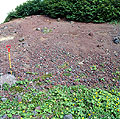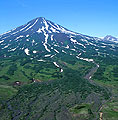1000-01
51°18' N, 156°53' E, summit elevation 2161 m
Kambalny (Figs. 1, 2) is the southernmost active volcano of the Kamchatka arc. This Holocene basaltic stratovolcano sits on the south tip of older hydrothermally altered volcanic ridge, just on the rim of a 5x3.5-km-large landslide crater (Fig. 3). Holocene edifice is strongly asymmetrical: it rises about 2000 above its south foot, and only 250 m above the older ridge at the north and 1000 m above the bottom of the landslide crater at the northeast.
Our studies have showed that in fact Kambalny consists of two cones: the western one formed in Early Holocene, and about 6000 14C yrs BP was destroyed by voluminous sector collapses, which formed the large crater and at least three debris avalanche units. The first avalanche traveled 14 km southeastwards. Then a series of strong explosive eruptions started to build a new cone east of the Early Holocene one. The next collapse involved both old and emerging cones and resulted in the second debris avalanche, which surmounted 350-m-high hills and formed a 5-km-wide and 20-km-long deposit SSW from the volcano (Figs. 4 and 5). The third debris avalanche involved altered rocks of the old ridge and also a part of the Holocene cone; it traveled more than 10 km northeastwards down the river valley. First two debris avalanche units are composed mostly of lava blocks and scoria from the Holocene volcano (Figs. 3 and 4), while the third one is dominated by strongly altered clayey rocks of the older ridge. Total volume of all the three units is roughly estimated at 5-10 km3, that is the largest Holocene collapse in Kamchatka. Subsequent eruptions have built a new cone (Fig. 1) and filled a part of the collapse crater. Earlier southern debris avalanche units have been mapped as moraines or lava fields.
Now the space between the hummocks of the debris avalanche deposits is occupied with peat bogs. The peat preserves all the thinnest ash layers from south Kamchatka volcanoes, which have covered this territory in the second half of Holocene (Fig. 6). This detailed stratigraphy allows us to provide a high-resolution radiocarbon dating of major explosive eruptions. The last large eruption of Kambalny occurred about 600 years ago; it was a phreatic eruption, which left a fan of debris on the SW slope of the volcano (Fig.6). Few smaller explosive eruptions occurred still later, some of them produced lahars (Fig. 7).
Kambalny produced low-potassic basalts-basaltic andesites.
Vera Ponomareva
Literature






